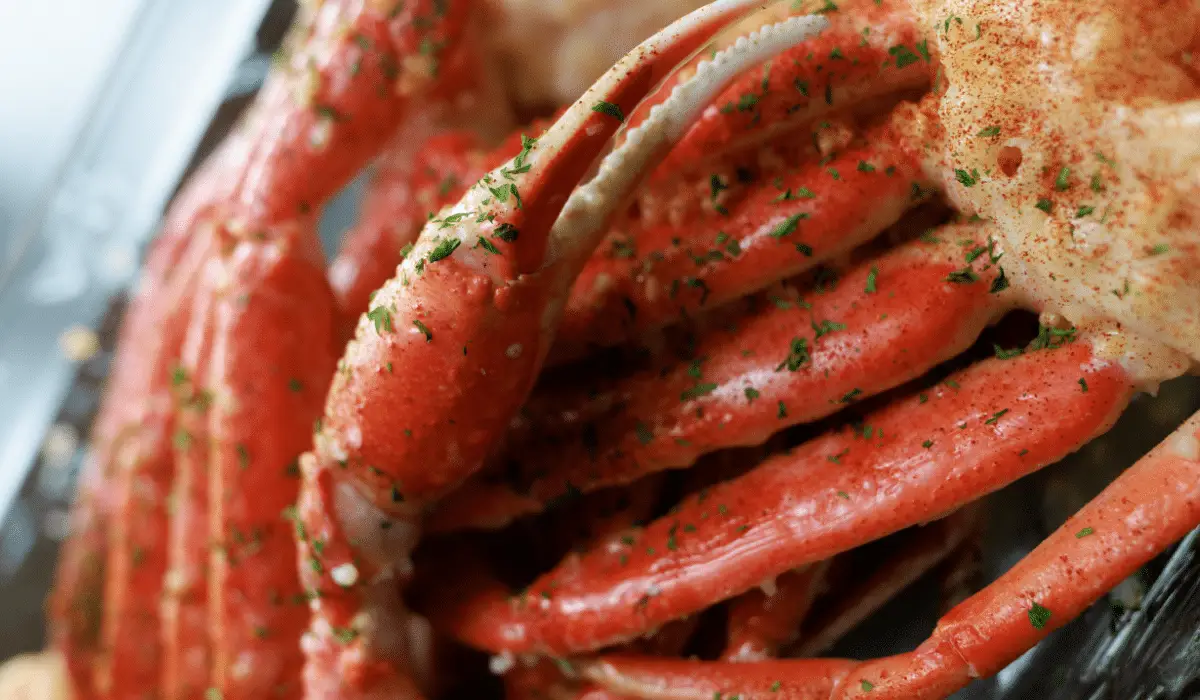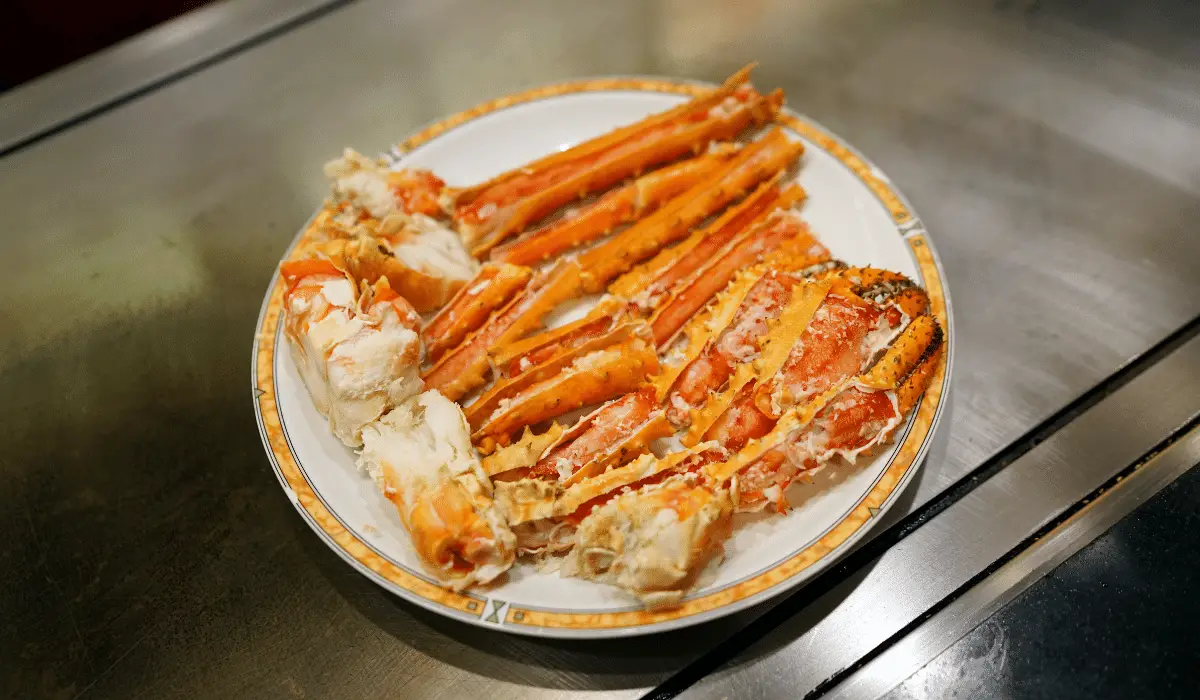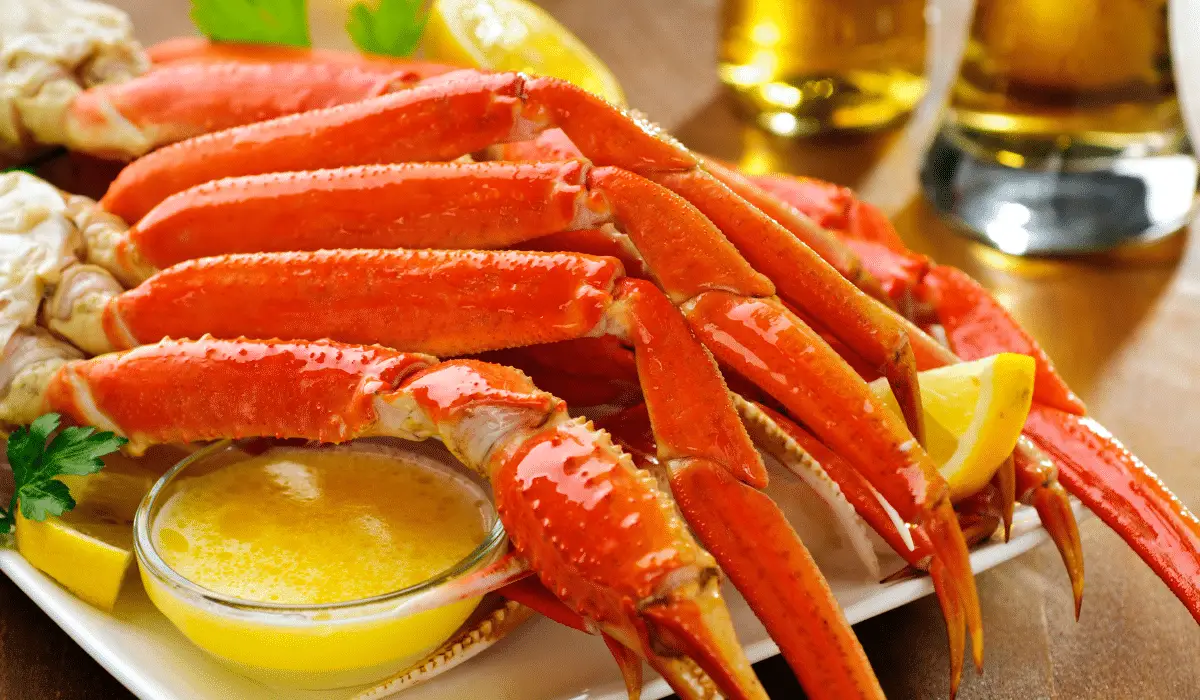Introduction
Crab legs, a true culinary treasure, offer a delightful journey into the world of gourmet seafood. This introduction to crab legs will guide you through the allure and versatility of this esteemed delicacy.
Understanding Crab Legs: A Delightful Delicacy
Now, let’s dive into understanding crab legs. Known for their sweet, tender meat, crab legs stand out as a favorite among seafood enthusiasts. They don’t just tantalize your taste buds; they also bring a touch of elegance to any dining experience. Moreover, crab legs are incredibly versatile. Whether steamed, grilled, or boiled, they adapt to various cooking methods, making them a perfect fit for any recipe.
So, why wait? Embark on this exciting culinary adventure and discover the rich flavors and joyous experiences that crab legs have to offer!
If you’re interested in exploring this topic further, our complete exploration can be found here Ultimate Crab Cake Sandwich Recipe: A Coastal Delight
The Basics of Crab Legs
Different Types of Crabs and Their Legs
Crab legs, a seafood lover’s delight, come from various crab species. Each species, like the King Crab and Snow Crab, offers distinct flavors and textures. King Crab legs are known for their large size and rich taste, while Snow Crab legs are smaller but equally delectable, with a subtly sweet flavor.
The Nutritional Value of Crab Legs
Crab legs are not just tasty; they’re also nutritious. They’re an excellent source of protein and contain essential vitamins and minerals, such as Vitamin B12 and Omega-3 fatty acids. These nutrients support brain health and heart function, making crab legs a healthy choice.
How to Select the Best Crab Legs
Choosing the best crab legs is simple. First, look for a fresh, briny scent. Avoid any crab legs with an overly fishy smell. Next, check the color; they should have a vibrant, natural hue without any dullness. Finally, feel the weight. Heavier crab legs usually mean more meat inside, ensuring a satisfying meal.
Discover more about this fascinating topic by accessing our full report here Does Imitation Crab Go Bad? Essential Shelf Life Guide
In summary, exploring the world of crab legs opens up a delightful culinary journey. From understanding different types, appreciating their nutritional value, to selecting the best ones, crab legs offer a versatile and wholesome experience for any seafood enthusiast.
For an expanded perspective and additional context, refer to our full article on Why is Crab So Expensive? An Insight into the Delicacy’s High Cost
Recipes and Serving Ideas
For more inspiration on diverse side dishes that perfectly complement crab legs, check out Diverse Side Dishes for Crab Legs at Bake It With Love. This resource offers a variety of side dish ideas that are ideal for enhancing your crab leg meal.
Health and Nutrition
The Health Benefits of Eating Crab Legs
Crab legs, a treasure trove of nutrients, offer remarkable health advantages. Firstly, they’re a lean source of high-quality protein, essential for muscle development and repair. Moreover, crab legs are rich in omega-3 fatty acids, crucial for heart health and reducing inflammation. They also provide a bounty of vitamins and minerals, including vitamin B12 and selenium, boosting immunity and energy levels.
For an in-depth understanding of the nutritional value and health benefits of crab meat, including its rich protein content, essential amino acids, and vitamins and minerals, explore the article “Nutritional aspects, flavour profile and health benefits of crab meat based novel food products and valorisation of processing waste to wealth: A review” on ScienceDirect. This review provides a comprehensive look at the various health-promoting properties of crab meat.
Dietary Considerations: Allergies and Cholesterol
When enjoying crab legs, it’s important to be mindful of dietary restrictions and health considerations. Individuals with shellfish allergies should avoid crab, as it may lead to severe allergic reactions. While being a low-fat option, crab legs do have cholesterol content, making moderation key, particularly for those monitoring their cholesterol intake. This careful approach ensures a safe and healthy dining experience.
Incorporating Crab Legs into a Balanced Diet
Incorporating this seafood into a balanced diet is both simple and advantageous. They are an excellent source of lean protein and fit well into healthy eating plans. The key is balance. Combining them with vegetables and whole grains creates nutritious, well-rounded meals. This strategy allows you to enjoy their health benefits while managing cholesterol. Therefore, when planning meals, consider this delicious and health-conscious option
For a deeper understanding and more detailed information on this topic, I highly recommend exploring Are Crab Cakes Healthy? Unraveling the Nutritional Facts
Buying and Storing
Sustainability and Ethics
Crab Legs in Different Cultures
The culinary world cherishes a variety of seafood, notably crab, for its unique flavors and cultural importance. In Japan, for instance, the arrival of winter is marked by the much-anticipated snow crab season. These crabs are a central feature in hot pots and sophisticated sushi creations. Meanwhile, in the United States, regions like Maryland and Alaska have their own ways of celebrating this seafood. Alaska is renowned for its large king crab, a staple on many menus, whereas Maryland is famous for its lavish crab feasts. This exploration into different cuisines highlights the adaptability and wide appeal of crab, underscoring its status as a favored ingredient in a multitude of global culinary practices.
Advanced Cooking Techniques
Perfecting the preparation of crab legs begins with the basics. If they’re frozen, ensure they’re properly thawed either overnight in the refrigerator or quickly under cold water. A key step is to gently crack their shells before cooking. This technique allows flavors to penetrate during the cooking process, enhancing the taste of each bite.
For a creative twist, experiment with unique flavor combinations. Marinating them in garlic butter and lemon juice prior to cooking is a classic approach. Alternatively, for an Asian-inspired flavor, try a blend of soy sauce, ginger, and a hint of honey. Such inventive approaches can transform these into a gourmet experience.
Chef’s Tips and Tricks
In mastering the art of seafood preparation, chefs emphasize the importance of precision, particularly with delicacies like crab. It’s crucial not to overcook them, aiming for just the right amount of heat, usually around 10 minutes, to ensure they’re perfectly warmed. A pro tip is to aromatize the cooking water. Ingredients like lemon slices, garlic, and herbs can subtly infuse the dish with rich flavors. When it comes to serving, the accompaniments make a significant difference. Combinations like drawn butter, lemon wedges, and a dash of seasoning enhance the overall experience.
To sum up, achieving excellence in seafood cooking, especially with dishes like crab, involves meticulous preparation, exploring innovative recipes, and applying professional advice. These techniques are key to enhancing your culinary skills, impressing your guests, and satisfying your passion for cooking. It’s a journey worth taking, full of discoveries in flavors and textures.
Garlic Butter Grilled Crab Legs Recipe
Ingredients:
- 2 lbs of crab legs (King or Snow crab preferred)
- 1/2 cup unsalted butter
- 4 cloves garlic, minced
- Juice of 1 lemon
- 1 teaspoon smoked paprika
- 1/2 teaspoon red pepper flakes (optional for a spicy kick)
- Salt and black pepper to taste
- Fresh parsley, chopped (for garnish)
- Lemon wedges (for serving)
Equipment:
- Grill
- Small saucepan
- Basting brush
- Aluminum foil
Instructions:
- Preparation:
- If the crab legs are frozen, thaw them overnight in the refrigerator or quickly under cold running water.
- Preheat your grill to medium-high heat.
- Make Garlic Butter Mixture:
- In a small saucepan, melt the butter over medium heat.
- Add the minced garlic and cook for 1-2 minutes until fragrant.
- Stir in lemon juice, smoked paprika, red pepper flakes, salt, and black pepper. Cook for another minute. Remove from heat.
- Prepare Crab Legs for Grilling:
- Rinse the crab legs and pat them dry with paper towels.
- Slightly crack the crab leg shells using a seafood cracker or a knife. This helps the flavors to infuse into the meat.
- Grill the Crab Legs:
- Brush the crab legs generously with the garlic butter mixture.
- Place the crab legs on the grill. Grill for about 4-5 minutes on each side. Regularly baste the crab legs with the garlic butter mixture while grilling.
- Serve:
- Once the crab legs are heated through and slightly charred, remove them from the grill.
- Arrange the crab legs on a serving platter. Drizzle any remaining garlic butter over them.
- Garnish with chopped parsley and serve with lemon wedges on the side.
Enjoy your delicious Garlic Butter Grilled Crab Legs, a perfect dish for seafood lovers and a great way to impress your guests at your next barbecue!
Frequently Asked Questions
1. What’s the Best Way to Cook Crab Legs?
The ideal method for cooking crab legs is either steaming or boiling. Steaming preserves their delicate flavor and maintains moisture, ensuring the meat remains succulent. Boiling is quicker and infuses the crab legs with the flavor of the cooking liquid.
2. Can I Cook Frozen Crab Legs Without Thawing?
Absolutely! Frozen crab legs can be cooked directly from the freezer. Just add a few extra minutes to the cooking time. This method is convenient and preserves the flavor and texture of the crab legs.
3. How Do I Know When Crab Legs are Fully Cooked?
Crab legs are done when they turn a bright red color and the meat is opaque and flaky. If you’re reheating pre-cooked crab legs, they just need to be heated through, which usually takes about 5 to 7 minutes.
4. What Are Some Good Sides to Serve with Crab Legs?
Classic sides include steamed vegetables, like asparagus or broccoli, a fresh garden salad, garlic bread, or roasted potatoes. These sides complement the rich flavor of the crab without overpowering it.
5. How Long Can I Store Cooked Crab Legs?
Cooked crab legs can be stored in the refrigerator for up to two days. Make sure they’re wrapped tightly or kept in an airtight container. For longer storage, freeze them for up to two months.
6. Are Crab Legs Healthy to Eat?
Yes, crab legs are a healthy choice. They’re low in calories, high in protein, and a great source of omega-3 fatty acids. However, they are high in sodium and cholesterol, so moderation is key, especially for those with dietary restrictions.
Conclusion
As our exploration concludes, it’s evident that crab legs are more than just a treat for the palate; they are a wholesome choice as well. Our journey has highlighted their impressive nutritional value, showcasing their richness in protein, omega-3 fatty acids, and essential vitamins. We’ve also considered important dietary factors, noting the need for moderation due to cholesterol and the precautions for those with shellfish allergies.
These offer a unique combination of exceptional taste and health advantages, making them a favored choice for both enthusiasts and culinary explorers. By experimenting with different cooking methods, you can unlock their full flavor potential. Whether through simple steaming or more elaborate recipes, they promise a voyage of delightful culinary experiences. Embracing these in your cooking can add a distinct and flavorful touch to your dining adventures.



3 thoughts on “Crab Legs: Ultimate Guide to Recipes, Health, and Tips”
Comments are closed.